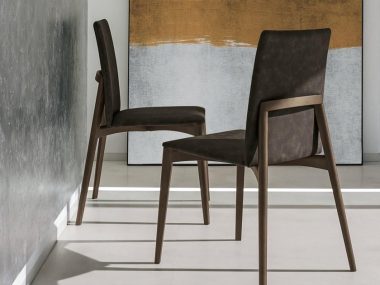Be the first to review “Daw” Cancel reply
Vitra
Daw
Upholstered fabric chair with armrests
Request a Quote
Add to WishlistRemove from Wishlist
Add to Wishlist
About Daw
Daw is a chair with armrests that features a polypropylene shell and inner fabric padding. Today the Plastic Chairs by Charles and Ray Eames seem like archetypes of the class of chairs whose shell can be joined with diverse bases. The blend of the wooden base with the plastic shell of the DAW (Dining Height Armchair Wood Base) produces a rich contrast of materials. The seat shells are also accessible with a seat cushion or full upholstery. Material description – Seat shell: colored through polypropylene. All models are accessible with a seat cushion (screwed to the seat shell) or full upholstery. The completely upholstered version has shaped polyurethane froth cushioning shrouded in fabric, appended to the shell with a welted edge. Different shell and upholstery colors and various bases give a large number of possible combinations. – Options: the Eames Plastic Chair is accessible as a visitor chair, eating chair, rocker, swivel chair or in stacking versions and with ganging brackets for line seating. Beam-mounted shells are suited for use in waiting areas. – Base: wooden base in various shades of maple or nectar conditioned ash, stained and lacquered finish. Steel bar cross struts in basic dark. (DAW = Dining Height Armchair Wood Base) – Origin of wood: ash (Fraxinus excelsior) and maple (Acer platanoides) from Western Europe or potentially Poland. ‘Getting the most of the best to the greatest number of individuals for the least’: with these words, Charles and Ray Eames described one of their primary goals as furniture designers. None of their different designs verge on accomplishing this ideal as the Plastic Chairs. For years, the designer couple investigated the major thought of a one-piece seat shell formed to fit the contours of the human body. After experiments with pressed wood and sheet aluminum during the 1940s produce unsatisfactory results, their search for elective materials drove them to glass-fiber supported polyester resin. The Eameses perceived and completely took advantage of the advantages of the material: mouldability, inflexibility, pleasant material qualities, suitability for industrial assembling methods. With this material, which was previously obscure in the furniture industry, they successfully fostered the shell designs for serial production. After their introduction for the ‘Minimal price Furniture Design’ rivalry coordinated by the Museum of Modern Art in 1948, the Plastic Armchair (A-shell) and Plastic Side Chair (S-shell) were dispatched available in 1950 as the absolute first mass-created plastic chairs in the history of furniture. The Eames Plastic Chairs also presented another furniture typology that has since become widespread: the multifunctional chair whose shell can be gotten together with a wide range of bases to serve diverse purposes. As right on time as 1950, Charles and Ray Eames presented a series of bases that empowered various sitting positions. An especially striking model is the so-called Eiffel Tower base – a many-sided and agile design made of steel wire that matchlessly combines light, exquisite forms with structural strength. Today Vitra manufactures the agreeable seat shells of the Eames Plastic Chairs in polypropylene, while those of the Eames Fiberglass Chairs are delivered in glass-fiber built up polyester resin. There is also a wide selection of bases and shell colors, alongside upholstery options for some models. This allows customers to specify countless various combinations and to use the chairs in the widest scope of settings – from lounge areas, parlors and work spaces to office workspaces and meeting rooms; from restaurants and cafés to break rooms and cafeterias; from waiting areas and auditoriums to terraces and gardens. In 2016, Vitra added about 20 mm to the base tallness of the Eames Plastic Chairs DSX, DAX, DSR, DAR, DSW and DAW while adjusting the seat calculation accordingly.
Attributtes:
| Collection | |
|---|---|
| Designer | |
| Product year | 1950 |
| Style | Modern |
| Materials | Fabric, Plastic |
| Country | Switzerland |
































Reviews
There are no reviews yet.